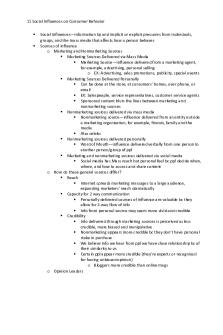Virtual methods - issues in social reserach on the Internet - chapter 11 PDF

| Title | Virtual methods - issues in social reserach on the Internet - chapter 11 |
|---|---|
| Course | Anthropology Interdisciplinary Dissertation |
| Institution | Oxford Brookes University |
| Pages | 2 |
| File Size | 68.1 KB |
| File Type | |
| Total Downloads | 90 |
| Total Views | 124 |
Summary
Bullet pointed summary of 'Chapter 11: Web sphere analysis: an approach to studying online action' in Hine (2005) ' 'virtual methods: issues in social research on the internet'....
Description
Virtual methods: Issues in Social Research on the Internet – Hine, C. ‘Chapter 11: Web Sphere Analysis: An Approach to Studying Online Action’
‘Online action - what people do (or do not do) – alone and together on the World Wide Web and via other Internet applications, is drawing the attention of a wide range of social researchers’ (p. 157)
Great quotation ‘The World Wide Web (hereafter referred to as ‘the web’) can be viewed as an evolving set of structures supporting online action, which manifests and enables the production, inscription and experience of cyberculture (cyber-culture?) – with a myriad of social, political and cultural dimensions’. (p.157) VERY relevant to my project.
‘The hyperlinked (hyper-linked?), co-produced and evolving characteristics of the web necessitate reconsideration of traditional research methods, and the development of new ones’ Justification of my methodology if it takes quite a unique turn/ path. (p. 157)
‘For instance, the hyperlinked and multilevel nature of the web makes the identification and demarcation of units of analysis a critical but difficult task.’ (p. 157) Could this be true of my ‘units of analysis’ being spread across multiple platforms (Snapchat, Instagram, Facebook, Whatsapp) and how to I demarcate them?
‘The co-produced nature of the web… makes problematic the attribution of authorship to producers of specific bits’ (p. 157)
The fast paced ‘evolution of the web’ (ibid.) is one of the biggest challenges faced by scholars as they look ‘to develop methodological approaches permitting robust examination of web phenomena over time’ the communication platforms I am approaching (Snapchat, Whatsapp, Facebook, Instagram) part of this evolution and my method (what ever it will consist of) as a robust enough approach to deal with this.
Notes the interdisciplinary nature of web based studies including those wishing to understand ‘relationships between these patterns and factors exogamous to the web’ (p.157) Is that me?
Talks about the ‘examination of web objects’ (p.157) – ‘texts, features, links and sites’ (ibid.), ‘inscriptions of web producers’ practices’ and ‘structures for online action on the part of web users’ (p. 157).
Researching online action (p.158) – web sphere analysis.
‘This approach centres on the concept of a web sphere as a unit of analysis, and provides an integrative framework for structural, rhetorical, and sociocultural methods of analysis’ (p. 158) sounds relevant, ‘integrative’ (accounting for the
mixture of content I will be presented with), ‘rhetorical’ (the speech that my informants will use) and ‘structural’ (The structures of the media platforms I will examine?)
Web sphere analysis: ‘a framework for web studies that enables analysis of communicative actions and relations between web producers and users developmentally over time’ Seems very relevant: ‘communicative actions’.
Read December (1996) This and other sources and journal articles employing this web sphere idea needed to gain better/ required understanding of this topic.
Presuming I don’t use this method, can mentioned reasons why: emphasis on ‘time, effort and storage’ (p.163) which I don’t have particularly; applies more to the internet and websites and therefore not applicable to communicative platforms such as Whatsapp. For instances, talks a lot about hyperlinks!
Potentially very relevant for picking what/ who to include/ examine One alternative to content relevance as the primary criterion for inclusion in the web sphere is the identification of relevant actor types, and the inclusion of web sites produced by identified actors. Relevant actor types can be determined in several ways, beginning with whatever extant literature informs a particular study, as well as through methods of social network analysis. Once relevant actor types are established, the web sites of particular actors within each type can be selected through carious indices and sampling techniques’ (p.163).
Consider quantitative content analysis in my project?
IDEAL STUFF Read final paragraph of p. 165 to end of that section. ESSENTAIL.
MUST READ HOWARD 2002! In bookmarks.
...
Similar Free PDFs

Ethical issues in the Mahabharata
- 19 Pages

Social Issues Lesson Plan
- 4 Pages

Essay social work methods
- 18 Pages

Issues on Human Development
- 4 Pages
Popular Institutions
- Tinajero National High School - Annex
- Politeknik Caltex Riau
- Yokohama City University
- SGT University
- University of Al-Qadisiyah
- Divine Word College of Vigan
- Techniek College Rotterdam
- Universidade de Santiago
- Universiti Teknologi MARA Cawangan Johor Kampus Pasir Gudang
- Poltekkes Kemenkes Yogyakarta
- Baguio City National High School
- Colegio san marcos
- preparatoria uno
- Centro de Bachillerato Tecnológico Industrial y de Servicios No. 107
- Dalian Maritime University
- Quang Trung Secondary School
- Colegio Tecnológico en Informática
- Corporación Regional de Educación Superior
- Grupo CEDVA
- Dar Al Uloom University
- Centro de Estudios Preuniversitarios de la Universidad Nacional de Ingeniería
- 上智大学
- Aakash International School, Nuna Majara
- San Felipe Neri Catholic School
- Kang Chiao International School - New Taipei City
- Misamis Occidental National High School
- Institución Educativa Escuela Normal Juan Ladrilleros
- Kolehiyo ng Pantukan
- Batanes State College
- Instituto Continental
- Sekolah Menengah Kejuruan Kesehatan Kaltara (Tarakan)
- Colegio de La Inmaculada Concepcion - Cebu











